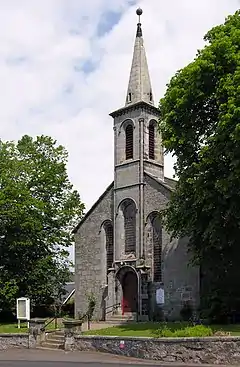Carnock
Carnock is a village and parish of Fife, Scotland, 4.2 miles (6.759 km) west of Dunfermline.[1] It is 1.3 miles (2.092 km) east of Oakley, Fife. The name of the village derives from Scottish Gaelic, from ceàrn meaning 'corner' with a locational suffix giving:"[the] corner place".[2] Carnock is known to have had military significance in antiquity.
| Carnock | |
|---|---|
 Carnock Parish Church | |
 Carnock Location within Fife | |
| OS grid reference | NT042890 |
| Council area | |
| Country | Scotland |
| Sovereign state | United Kingdom |
| Police | Scotland |
| Fire | Scottish |
| Ambulance | Scottish |
| UK Parliament | |
| Scottish Parliament | |
| Website | http://carnockgowkhall.wix.com/home# |
The civil parish has a population of 5,927 (in 2011).[3]
Notable places

On the Main Street of Carnock lies a Parish church which was built in 1840, though in the nearby kirkyard lies the remains of the original 12th-century church which was rebuilt in 1602.
Nextdoor to the church is Carnock Primary School, this school serves both Carnock and Gowkhall. The school was built in 1864 with an extension added in 1912 and another in 2007. The main building consists of 4 classrooms and a medway hut used for various purposes.
Carnock Olympian:- Former pupil at Carnock Primary was Debbie Knox part of the Gold Medal winning team at the Winter Olympics in Curling at Salt Lake City. She did come back to the school to show her Medal to the pupils and crown the Gala Queen.
On Main Street is the 16th-century The Carnock Inn, one of the oldest buildings in the village, which became a public house in 1884. Next door to the Pub is a local craft shop / studio in what used to be the village Post Office . Now Oakley serves as the Post Office for Carnock.
The village also boasts a Community Centre built in 2005 and available for hire via Fife council.
History
In 1774 upon Carneil hill, near Carnock, several urns containing Roman coinage were discovered. It is believed that the local inhabitants, the Horestii, unsuccessfully defended this location against the Roman general Gnaeus Julius Agricola. The local names Easter Camps and Wester Camps are suspected to originate from this time. Another native fort is located at the nearby Craigluscar only 2 miles away. Subsequent Roman encampments are suspected 3 miles east of Dunfermline and a large camp at Loch Ore.
The Church in Carnock was held from 1592 to 1645 by the ecclesiastical historian John Row. Latterly the parish was overseen by Thomas Gillespie from 1741 to 1752. Thomas Gillespie was founder of the Relief Synod which was latterly incorporated into the United Presbyterian Church.
Transport
The village has two bus stops.
- Eastbound Traveline Code : 34325459
- Westbound Traveline Code : 34325439
Services run from Dunfermline bus station serving Gowkhall, Oakley and Saline, Fife.
Notes
- Samuel Lewis (1851). A Topographical Dictionary of Scotland: Comprising the Several Counties, Islands, Cities, Burgh and Market Towns, Parishes, and Principal Villages, with Historical and Statistical Descriptions: Embellished with Engravings of the Seals and Arms of the Different Burghs and Universities. S. Lewis and Company. pp. 194–.
- "Carnock". Fife Place-name Data. Retrieved 22 May 2020.
- Census of Scotland 2011, Table KS101SC – Usually Resident Population, publ. by National Records of Scotland. Web site http://www.scotlandscensus.gov.uk/ retrieved March 2016. See “Standard Outputs”, Table KS101SC, Area type: Civil Parish 1930
| Wikimedia Commons has media related to Carnock. |